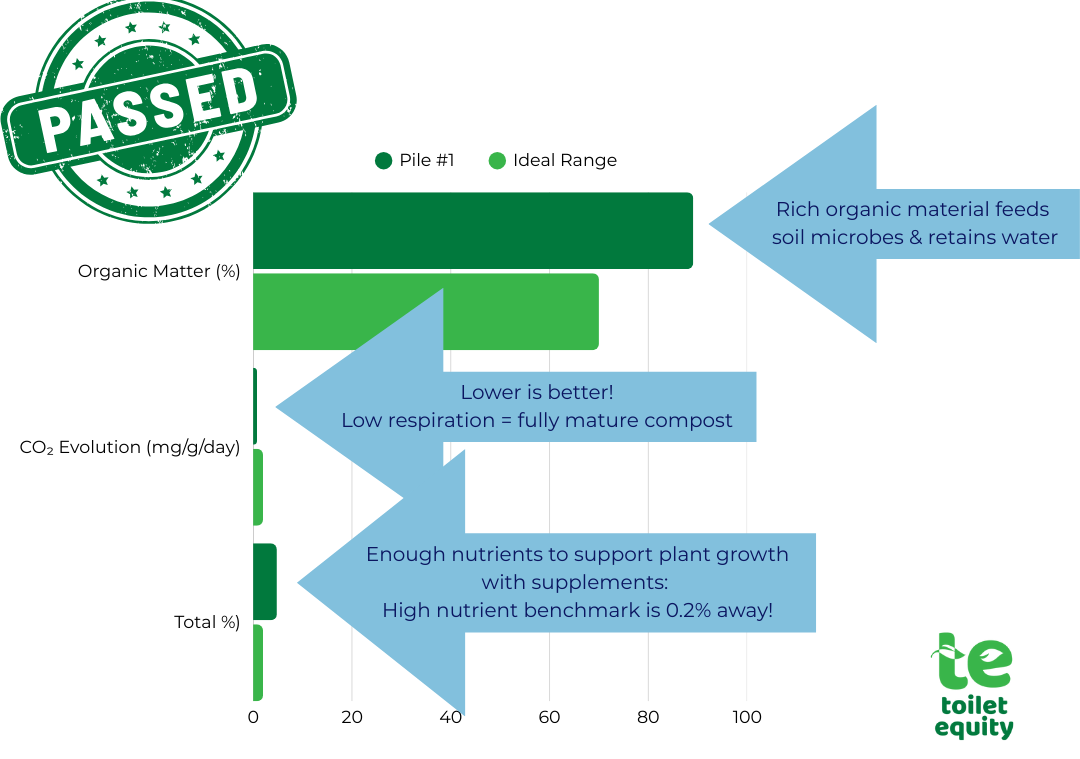From Poo to Powerful Compost
What Happens After the "Flush" (Hint: It's Safe, Stable, and Soil-Building!)
We’ve got big news:
Our first full compost pile has completed testing—and the results are incredible. After months of careful maintenance and composting, what started in a toilet is now lab-certified as stable, mature compost, safe for use in soil-building projects.
Here’s the lowdown on what we learned—and why it matters.
Compost That Passes the Test
We submitted a sample of our fully composted pile to a certified lab for testing. These tests check for everything from pathogens to nutrients to environmental safety. Our results show:
Very low CO₂ evolution (0.78 mg CO₂/g OM/day) — this tells us our compost is well-finished, not still breaking down
No detectable E. coli — it’s pathogen-free and safe
A whopping 89% organic matter — great for improving soil structure
Moderate nutrients, especially phosphorus and potassium
Low nitrogen, which is common in compost made from human waste and carbon-rich materials
What Does That Mean?
In plain English: our compost is safe, mature, and rich in organic matter. It’s not high-nitrogen like manure or chemical fertilizer, but it’s ideal for rebuilding depleted soil, improving water retention, and feeding plants over time.
It’s especially good for:
Soil restoration projects
Mulching around trees and shrubs
Amending garden beds with other nitrogen sources
Community landscapes that need long-term soil health
What About the Salt?
One interesting note: our compost has higher salinity than ideal for some crop applications (though our germination rate for cucumber seeds was 100%!). That’s likely a mix of two factors:
Human urine naturally contains more salts than animal manure.
Our carbon materials (like straw and sawdust) come from the Grand Valley, where ancient marine sediments make the soil itself salty.
We’re actively working on solutions, including:
Experimenting with tree leaf mold, which binds salts and improves compost texture
Balancing future piles with carbon sources from less saline areas
Targeting uses where salinity is less of a concern (like landscaping, not row crops)
What About the Chunky Bits?
Another thing we noticed in the lab results: our compost has a higher-than-average particle size, with about 7% of the material larger than ¼ inch. That’s not a flaw—it’s a conscious choice.
We sift all our finished compost to remove any debris (like trash or needles) that might’ve been dropped in the toilet, but we don’t sift it down to a super-fine texture like some commercial bagged composts. Why?
Because all those fibrous, partially broken-down bits—especially from straw, hay, and sawdust—are still doing good work in the soil. They:
Hold moisture
Feed soil microbes over time
Improve structure and aeration
That said, larger particles aren’t for every application. They can be tricky in potting mixes, golf course turf, or delicate seed-starting blends. But they’re perfect for:
Topdressing around trees, shrubs, and perennials
Blending into raised beds or community gardens
Mulching pathways or low-traffic landscape areas
Amending compacted or depleted field soil
We’re also watching to see if our newer compost piles—where we’ve adjusted the hydration process during composting—break down more completely. Our hope is that improved moisture management will reduce particle size naturally while still keeping all the nutrient and structural benefits.
Why It Matters
This compost pile represents a real-world win for safe, circular sanitation. Every bucket dumped and every scoop of sawdust added helped create something that can rebuild soil instead of polluting water. Our toilet users are not just managing waste—they’re making compost.
This is community-scale sanitation at its best:
Safe. Simple. Soil-building.
Want to Dig Into the Data?
Thank you for believing in this work and this vision. You made this possible—and the soil will thank you too.
With (compost-safe) gratitude,🪵
The Toilet Equity Team









